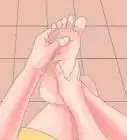This article was medically reviewed by Troy A. Miles, MD. Dr. Miles is an Orthopedic Surgeon specializing in Adult Joint Reconstruction in California. He received his MD from the Albert Einstein College of Medicine in 2010, followed by a residency at the Oregon Health & Science University and fellowship at the University of California, Davis. He is a Diplomat of the American Board of Orthopaedic Surgery and is a member of the American Association of Hip and Knee Surgeons, American Orthopaedic Association, American Association of Orthopaedic Surgery, and the North Pacific Orthopaedic Society.
There are 18 references cited in this article, which can be found at the bottom of the page.
wikiHow marks an article as reader-approved once it receives enough positive feedback. In this case, 100% of readers who voted found the article helpful, earning it our reader-approved status.
This article has been viewed 276,904 times.
Restless leg syndrome (RLS) causes unpleasant feelings in the legs, including crawling sensations, prickling, aching, tickling sensations, and an urge to move the legs when sitting down or lying in bed. These symptoms can cause sleep disruption and result in a lower quality of life for RLS sufferers. Although the precise cause of the disorder is still not known, there are factors that seem to predispose a person to it, including genetics, gender, and age. Many find that certain lifestyle changes prevent or mitigate the symptoms of RLS.
Steps
Preventing RLS Symptoms
-
1See if you’re predisposed to having RLS. Certain people are more likely to get RLS, either because it runs in their families or because they have a condition that causes RLS to occur. Knowing which RLS risk factors affect you can help you figure out the best way to prevent and lessen the symptoms since you’ll be able to address the cause of your RLS.[1]
- Iron-deficiency anemia, varicose veins, diabetes, and lung disease can all cause RLS. If you have one of these conditions, getting appropriate medical treatment may also help to prevent RLS from occurring.
- Twenty-five percent of pregnant women experience RLS, but it usually goes away at the end of pregnancy. During pregnancy, there are lifestyle changes you can make to prevent or ease the symptoms.
- If any of your close family members have had RLS, your chances of having it may be increased. There’s nothing you can do to alter this risk factor, but you can make changes to prevent or lessen the symptoms.
- Being overweight or obese can predispose you to RLS more readily. Taking steps to lose weight may help prevent RLS.
-
2Get active. Those with a sedentary lifestyle seem to be more prone to getting RLS. Include more exercise in your daily routine but start gradually, especially if you've not exercised for a while. The kind of exercise that is most beneficial is anything moderately strenuous, and doing it regularly.[2] Try swimming, cycling, walking fast, running, gym work, yoga, and so on.[3]
- Brisk walking four times a week for 30 minutes at a time has been shown to lessen the severity of RLS over a few months.
- Intense leg workouts can help. Try a week of daily intense leg exercises lasting around 20 to 30 minutes; cycling or fast walking are excellent choices.
- Swimming is a very gentle way to stretch leg muscles, especially if other forms of exercise cause you to cramp when stretching.
- Exercise not only helps to prevent RLS but can also help to reduce symptoms if they are already present.
Advertisement -
3Wear supportive footwear. Over time, wearing the wrong types of shoes or walking barefoot can cause your arches to fall. See a foot specialist who will help you to determine if fallen arches are contributing to your RLS. Your foot specialist will be able to recommend actions to take.[4]
- You can buy arch inserts at many shoe stores. Wearing these inside your shoes will help to support your arches and can help to relieve your RLS symptoms.
- You may find it uncomfortable to walk on hard floors in bare feet; try wearing slippers around the house to soften your landing.
-
4Drink plenty of water. Keep hydrated and meet your water needs every day. Drinking plenty of water is thought to help to reduce RLS. The amount of water needed to keep you adequately hydrated is dependent on your personal needs and health. As a general rule, drink water every time you get thirsty, and substitute water for coffee, sugary drinks and alcohol as often as possible.[5]
-
5
-
6Minimize your alcohol intake. Alcohol seems to exacerbate RLS, so try to reduce your intake and don't consume alcohol in the evenings. If you are a woman of any age or a man over 65, then have no more than one drink per day. If you are a man under 65, then have no more than two drinks per day.[8]
-
7Quit smoking. The risk of RLS seems to be higher for people who smoke. To prevent RLS, eliminate or reduce the number of cigarettes you smoke per day, and cut out any other products that contain nicotine.[9]
-
8Try doing mentally stimulating activities. If you find that your legs bother you during a period of rest (provided it is not bedtime, and you are not trying to sleep), then try doing something that will stimulate your mind. For instance, doing crossword puzzles, reading, writing, or working on the computer can be a way to distract your mind, which can in turn actually alleviate symptoms of RLS and/or prevent them from starting in the first place.[10]
-
9Check the side effects of drugs you’re taking. Quite a few drugs can be problematic, including anti-psychotic drugs, anti-nausea drugs, antidepressants that increase serotonin and some cold and allergy medications that contain antihistamines.[11]
- If you're taking a medication that lists RLS as a side effect, talk to your doctor about other options.
-
10Try taking iron supplements. Note, however, that this must be done with caution, as too much iron can be problematical for the body. It is wise to consult your doctor before trying this approach to ensure that it is a safe option for you.[12]
- Low iron (measured as ferritin in the blood) has been shown to be correlated with increased symptoms of RLS. Therefore, for people with low iron levels (as shown on blood tests), taking iron supplements can be helpful in the prevention of symptoms.
- However, doctors do not advise to take iron supplements by symptoms alone, without first getting a blood test confirming low values, as it can put you at risk of elevating your iron levels too much. Always talk to your doctor before proceeding with iron as a means of preventing RLS.
-
11Talk with your doctor about getting a drug prescription. Two drugs have been approved by the FDA for the treatment of restless leg syndrome: Requip (Ropinirole) and Mirapex (Pramipexole). These drugs are designed to be used specifically as the treatment for RLS. Depending on your symptoms, your doctor may also prescribe one of the following types of drugs to treat your RLS and to prevent symptoms:[13]
- Sedatives (such as clonazepam and zaleplon) are helpful for those whose sleep is disrupted by RLS.
- Anticonvulsants (such as carbamazepine) are helpful for people who deal with daytime RLS symptoms.
- Pain relievers are prescribed to patients with severe RLS.
-
12Consider complementary or alternative health techniques. Massage and acupuncture may also help prevent RLS symptoms. A massage can reduce tension in your legs and relax you as well.[14] Acupuncture has shown some benefit for RLS in some studies, but the results are not conclusive.[15]
- Consider scheduling yourself a massage or acupuncture treatment.
Getting Better Sleep
-
1Practice proper "sleep hygiene." "Sleep hygiene" is a term used by doctors to describe healthy and consistent sleep habits. It entails:[16]
- Waking up at the same time every day.
- Going to bed at a good hour that will allow you to wake up when your alarm goes off, and not to sleep in any longer.
- If you need more sleep, go to bed earlier, rather than waking up later as wake-up time is the most important factor in consistent sleep habits.
- Keep your wake-up time the same on weekends as on weekdays (for consistency).
- Avoid "screen time" (televisions, computer screens, and/or cell phones) right before bed as they wake your brain up with the radiation they emit, making it more difficult to fall asleep.
- Keep in mind that good sleep helps to prevent symptoms of RLS, both in the daytime and during subsequent nights. Therefore, the benefit is twofold - not only does "sleep hygiene" help you to fall asleep better (as a common symptom of RLS is trouble sleeping), it also diminishes and prevents the presence of symptoms in subsequent days.[17]
-
2Try stretching before bed. Winding down with some leg stretches before going to bed can help your legs loosen up and relieve tension. While there’s no conclusive evidence that stretching will prevent RLS, some find it beneficial.[18]
- Try gentle forward bends, backward bends, spinal twists, chair pose, and warrior pose in a slow method putting attention on breath.[19]
- Yoga poses that contract the thigh muscles; stretch the calves, hamstrings, and gluteal muscles; or flex and extend the solar plexus and pelvis are beneficial.
-
3Take a walk when you need to. If you feel RLS symptoms and simply can’t get to sleep, try giving in to the urge to move. Get up and take a walk, even if it’s just around the house. For some people, obeying the urge to walk can sometimes be enough to quell the strange sensations and allow them to get back to sleep again.[20]
-
4Reduce your stress levels. People who are stressed tend to sleep poorly and seem to be more prone to suffering from RLS.[21] Find outlets for relieving stress and ways to cope with it rather than allowing it to dominate your life and affect your health.[22]
- If you can't manage your stress effectively, make an appointment with a therapist. Some problems are difficult to solve without professional help, and it’s worth pursuing every resource when your health is on the line.
-
5Take a hot or cold shower before bed. Many have found that either a hot or cold shower can help prevent RLS symptoms and aid in a getting a good night’s sleep.[23] Try both a hot and a cold shower to see which method works better for you. On nights when you anticipate having trouble sleeping, jump in the shower before you go to bed.
Warnings
- If your symptoms aren't improving or are getting worse, speak to your doctor. Don't self-medicate in the hope it will go away; it won't if it hasn't already and it could be masking something more serious.⧼thumbs_response⧽
- Do not take iron tablets without your doctor's advice and if you miss taking it, never double up to make up for the missed supplement.⧼thumbs_response⧽
References
- ↑ https://my.clevelandclinic.org/health/diseases/9497-restless-legs-syndrome
- ↑ https://www.ninds.nih.gov/health-information/patient-caregiver-education/fact-sheets/restless-legs-syndrome-fact-sheet
- ↑ https://www.ncbi.nlm.nih.gov/pmc/articles/PMC5003313/
- ↑ https://www.helpguide.org/articles/sleep/restless-leg-syndrome-rls.htm
- ↑ https://www.epda.eu.com/about-parkinsons/symptoms/motor-symptoms/restless-legs-syndrome/
- ↑ http://www.uptodate.com/contents/treatment-of-restless-legs-syndrome-willis-ekbom-disease-in-adults
- ↑ https://health.clevelandclinic.org/home-remedies-for-restless-legs-syndrome/
- ↑ https://health.clevelandclinic.org/home-remedies-for-restless-legs-syndrome/
- ↑ https://www.nhs.uk/conditions/restless-legs-syndrome/treatment/
- ↑ https://www.uptodate.com/contents/management-of-restless-legs-syndrome-and-periodic-limb-movement-disorder-in-adults
- ↑ https://www.helpguide.org/articles/sleep/restless-leg-syndrome-rls.htm
- ↑ https://www.hopkinsmedicine.org/neurology_neurosurgery/centers_clinics/restless-legs-syndrome/what-is-rls/treatment.html
- ↑ https://www.ninds.nih.gov/health-information/patient-caregiver-education/fact-sheets/restless-legs-syndrome-fact-sheet#5
- ↑ https://my.clevelandclinic.org/health/diseases/9497-restless-legs-syndrome#management-and-treatment
- ↑ https://apm.amegroups.com/article/view/82101/html
- ↑ https://www.cdc.gov/sleep/about_sleep/sleep_hygiene.html
- ↑ https://www.uptodate.com/contents/management-of-restless-legs-syndrome-and-periodic-limb-movement-disorder-in-adults
- ↑ https://www.helpguide.org/articles/sleep/restless-leg-syndrome-rls.htm
- ↑ http://health.nytimes.com/health/guides/disease/restless-leg-syndrome/treatment.html
- ↑ https://www.hopkinsmedicine.org/neurology_neurosurgery/centers_clinics/restless-legs-syndrome/what-is-rls/
- ↑ https://medlineplus.gov/ency/article/000807.htm
- ↑ https://my.clevelandclinic.org/health/articles/8133-stress-10-ways-to-ease-stress
- ↑ https://health.clevelandclinic.org/home-remedies-for-restless-legs-syndrome/
-Step-01.webp)
-Step-02.webp)
-Step-03.webp)
-Step-04.webp)
-Step-05.webp)
-Step-06.webp)
-Step-07.webp)
-Step-08.webp)
-Step-09.webp)
-Step-10-Version-3.webp)
-Step-11-Version-3.webp)
-Step-12-Version-3.webp)
-Step-13-Version-2.webp)
-Step-14-Version-2.webp)
-Step-15-Version-2.webp)
-Step-16-Version-2.webp)
-Step-17-Version-2.webp)






























































Medical Disclaimer
The content of this article is not intended to be a substitute for professional medical advice, examination, diagnosis, or treatment. You should always contact your doctor or other qualified healthcare professional before starting, changing, or stopping any kind of health treatment.
Read More...